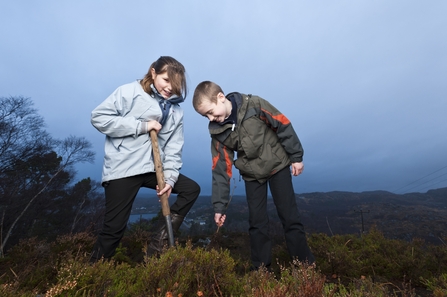
The Wildlife Trusts want to inspire one in four people to take action for nature © Ben Hall/2020VISION

The Wildlife Trusts want to inspire one in four people to take action for nature © Ben Hall/2020VISION
We want to really motivate people to do things on their own and take steps in their local neighbourhoods to bring back wildlifeStephen Trotter, CEOCumbria Wildlife Trust
New plans announced today will mean that people will be able to experience nature in a way that they may never have done before – with large, populated areas butting up against large rewilded landscapes, say The Wildlife Trusts. The charities’ new Strategy 2030, launched today, shows how people will be at the heart of vast nature restoration projects that will do more than just halt the decline of nature – they will reverse it instead.
The UK is one of the most nature-depleted countries in the world and, with 41% of species in decline since the 1970s plus 15% of species at risk of extinction, urgent action is required to stop hedgehogs, water voles, and red squirrels disappearing forever. The Wildlife Trusts plan to empower people to reverse the trend.
Craig Bennett, chief executive of The Wildlife Trusts, says:
“The situation is dire and nature needs to be put in special measures – we must ramp up action as never before by triggering a decade of nature restoration. Conservation of the wildlife and habitats that remain is no longer enough because what we’ve got left is so fragmented and diminished. In the past we’ve focused on preserving habitats and species – now we need to restore the abundance of nature, and with it, the ecosystem processes that’ll get nature working again.
“Despite the huge loss of wild places and wildlife that depends on them, there is hope. The UK has committed to protecting and managing 30% of land for nature by 2030 and we’re going to be working with all national governments and local authorities to make sure this happens.”
The Wildlife Trusts have three new goals:
Stephen Trotter, Chief Executive of Cumbria Wildlife Trust, was asked on BBC Radio 4 Farming Today about how these goals will be met:
"We're going to acquire new land, working with landowners, farmers and others to really influence how we look after our landscape ... We already work in partnership with farmers and landowners in Cumbria, we just want to do more of it. A key part of the strategy is encouraging, supporting and mobilising as many people as we can - hopefully one in four will be taking action for wildlife ... We want to really motivate people to do things on their own and take steps in their local neighbourhoods to bring back wildlife. We'll invest in supporting communities, to ensure that people feel empowered to take action locally, to make sure that their local patch is the best that it possibly can be for wildlife and the environment."
He talked about the success story of ospreys returning to Foulshaw Moss Nature Reserve, along with other species, such as the grasshopper warbler, following large-scale habitat restoration, saying: "This is a transformed landscape and that's what we've got to see across the UK."
Craig Bennett, chief executive of The Wildlife Trusts, says:
“Nature needs people to act now before it’s too late and we can all be part of the effort to restore our natural world at the scale so desperately needed. We’ve found that people want to get involved, and The Wildlife Trusts – with staff in every part of the UK – are well placed to enable this to happen. It’s up to us all – businesses, landowners, schools, governments, and individuals – to heal our natural world.”
Liz Bonnin, President of The Wildlife Trusts, says:
“We can succeed at putting nature into recovery if we all work together as one interconnected community. Our precious ecosystems – all interconnected and interdependent themselves – need to be able to do their job in maintaining the health of our planet. The Wildlife Trusts’ Strategy is harnessing the tremendous amount of expertise from all 46 Trusts to restore our wild places, putting people at the heart of it all. It’s time to fall in love with our planet again, and become the responsible custodians it deserves.”
Wildlife decline and loss statistics
Wildlife losses also include the disappearance of 97% of lowland meadows that support wildflowers, insects, mammals, and birds (State of Nature (SoN), 2013, page 14); 80% of purple heathlands which are home to bilberries, sand lizards and curlew (SoN 2013, page 24). Rivers are in deep trouble too: in England, only 14% of rivers meet standards for good ecological status, much of this is due to agricultural pollution, causing 13% of freshwater and wetland species in to be threatened with extinction. Butterflies and moths have been particularly hard hit with numbers down by 17% and 25% respectively. Mammals also fare badly with more than 26% of species at risk of disappearing altogether. UK wildlife declines are documented in State of Nature reports 2013, 2016 and 2019.
30% of land and sea for nature by 2030
The 30% threshold of wildlife habitat in a landscape has been worked out by looking at a range of different species and their requirements. At less than 30% cover, habitat patches are too small and isolated, and species richness (the number of species in any one area), abundance and survival rates decline. This is what has led to the UK becoming one of the most nature depleted countries on Earth. Where habitat cover is greater than 30% habitat patches will, on average, be larger and the distance between patches will typically be less, resulting in greater connectivity. This means that if local extinctions do occur, other populations of the same species can move into the area easily.